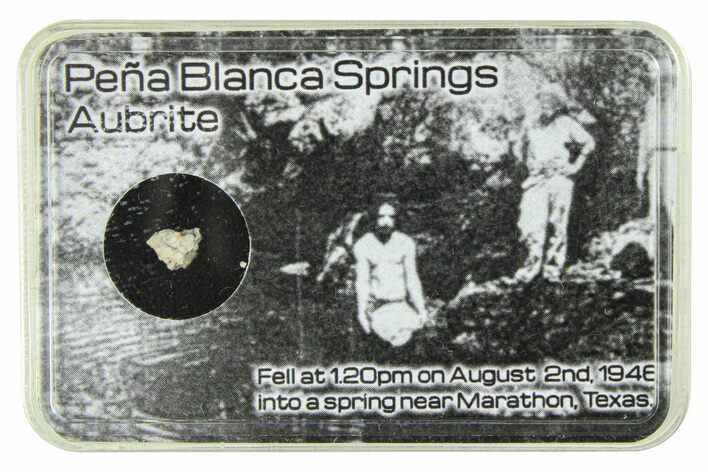0.18" Aubrite Meteorite Fragment - Peña Blanca Springs
This is a 0.18" fragment (0.05 grams) from the Peña Blanca Springs meteorite, an unusual kind of achondrite called an aubrite that fell into a swimming pond on a ranch near Marathon, Texas in 1946. It comes in a bespoke acrylic display case.
The Peña Blanca Springs meteorite is an aubrite that fell near the town of Marathon in western Texas on August 2, 1946. It landed in the middle of a swimming pond at the headquarters of the historic Gage Ranch! Approximately 70 kilograms were recovered, mostly as two large stones.
The stone is a breccia of cream-colored, enstatite-rich clasts with occasional darker clasts within. Its fusion crust is usually cream to a light gray.
The stone is a breccia of cream-colored, enstatite-rich clasts with occasional darker clasts within. Its fusion crust is usually cream to a light gray.
About Aubrites
Aubrites are a unique class of achondritic meteorites that represent some quite extreme formation conditions in the early solar system. Aubrites are almost all breccias consisting of whitish enstatite, with occasional inclusions of olivines, nickel-iron, and troilite, along with impact-melted clasts seen in achondrites.
Enstatite is a form of orthopyroxene that forms in igneous conditions and is considered an early stage of mineral formation in the solar system. Enstatite meteorites likely originate from E-type (enstatite-rich) asteroids close to the sun, particularly the near-Earth object 3130-Eger. It has even been observed outside of the solar system around evolved stars and planetary nebulae!
Aubrites are a unique class of achondritic meteorites that represent some quite extreme formation conditions in the early solar system. Aubrites are almost all breccias consisting of whitish enstatite, with occasional inclusions of olivines, nickel-iron, and troilite, along with impact-melted clasts seen in achondrites.
Enstatite is a form of orthopyroxene that forms in igneous conditions and is considered an early stage of mineral formation in the solar system. Enstatite meteorites likely originate from E-type (enstatite-rich) asteroids close to the sun, particularly the near-Earth object 3130-Eger. It has even been observed outside of the solar system around evolved stars and planetary nebulae!
About Achondrites
Achondrites are a type of stony meteorite that lacks chondrules--round grains that aggregate from molten or partially molten droplets in space to form chondrites. Achondrites still contain grains, but their textures are extremely distinct and analogous with igneous processes rather than the chondrule-producing conditions at the beginning of the solar system.
Achondrites make up about 8 percent of all known meteorites. They are almost all regolith breccias, ejected from impacts on larger asteroids and sometimes the moon and Mars. Most are HED (howardite-eucrite-diogenite) in composition, sourced from the asteroid Vesta: it is the second largest asteroid in the Solar System and the only asteroid visible to the naked eye.
Achondrites are a type of stony meteorite that lacks chondrules--round grains that aggregate from molten or partially molten droplets in space to form chondrites. Achondrites still contain grains, but their textures are extremely distinct and analogous with igneous processes rather than the chondrule-producing conditions at the beginning of the solar system.
Achondrites make up about 8 percent of all known meteorites. They are almost all regolith breccias, ejected from impacts on larger asteroids and sometimes the moon and Mars. Most are HED (howardite-eucrite-diogenite) in composition, sourced from the asteroid Vesta: it is the second largest asteroid in the Solar System and the only asteroid visible to the naked eye.
$29
TYPE
Enstatite Achondrite (Aubrite)
LOCATION
Gage Ranch, Marathon, Texas
SIZE
0.18" wide, 0.05 grams
CATEGORY
SUB CATEGORY
ITEM
#286043
 Reviews
Reviews









